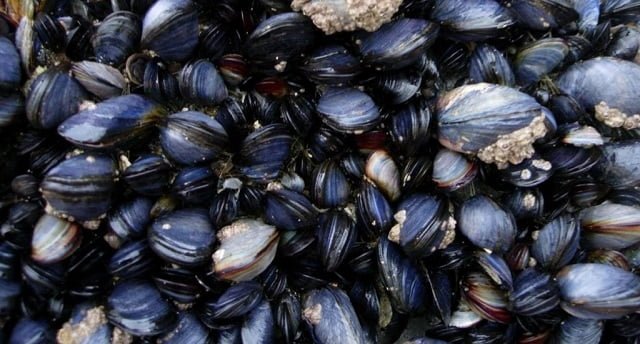
While most people associate aquaculture with fish farms, a different type of aquaculture is gaining ground: low-trophic aquaculture. This involves raising bivalve mollusks and seaweed (creatures found at the lower levels of the food chain) and offers a promising path to sustainable food production. But the benefits may extend beyond our plates.
While the ecological potential of mussel and seaweed farms is intriguing, concrete data on the fish communities they support are lacking. Researchers from the Marine Biological Association (MBA) and the University of Exeter teamed up to conduct a study of fish populations around two integrated blue mussel (Mytilus edulis) and seaweed (Saccharina latissima) farms in the UK, to determine whether these aquaculture sites help or hinder fish abundance and diversity.
More Fish, More Species: A Thriving Underwater Community
A recent study conducted in the southwest UK investigated the impact of mussel and seaweed farms on fish communities. Researchers used baited remote underwater video (BRUV) units and fishing techniques to assess fish populations around these farms and compared them to areas without aquaculture activity.
The researchers found a diverse community of at least 11 fish species, including commercially valuable ones. Crucially, both mussel and seaweed farms had significantly higher fish abundance and species richness compared to areas outside the farms.
Mussel and seaweed farms act like underwater apartment buildings, providing much-needed food, breeding grounds, and nurseries for diverse fish species. This is especially important for commercially valuable fish and those crucial for maintaining healthy marine ecosystems. The results were clear:
- Fish Paradise: Significantly higher quantities and varieties of fish were found near mussel and seaweed farms compared to non-aquaculture areas. The new study identified several commercially and ecologically important fish species using the farmed areas, such as mackerel, haddock, and sand eels, and diet analysis reveals that the farms can provide new and important feeding grounds for these species.
- Seaweed Revolving Door: Seaweed farms provided temporary refuge for fish due to seasonal harvesting practices.
- Mussels: The Stable Landlord: Mussel farms offered a more stable long-term habitat due to their overlapping growth cycles, ensuring a constant presence of food and shelter.
- Food Chain Benefits: Examining the stomach contents of fish caught near the farms revealed another fascinating aspect. Some fish fed heavily on amphipods, small crustaceans that feed on organic matter found on the farms. This suggests that the farms not only attract fish but also support the growth of their natural food sources. Further up the food chain, researchers found larger fish stomachs containing smaller fish species, a clear sign that these farms provide valuable hunting grounds, potentially boosting secondary and tertiary production within the ecosystem.
- Possible Breeding Grounds? While not definitively identified at the species level, the study also found a significant presence of juvenile fish at both farms. This suggests that the farms could be acting as nurseries or breeding grounds for younger fish populations. However, more research is needed to confirm this interesting possibility.
Overall Impact: A Sustainable Future for Fish and Food
Lead author Sophie Corrigan, who conducted the monitoring as part of her PhD at the MBA and Exeter University, said: “Given the degradation of natural habitats around our coasts, the decline of many important fish populations, and the clear need to increase sustainable food systems, these results provide important evidence on how shellfish and seaweed farms could be used as solutions if managed appropriately. The increased abundance of fish within these farms will likely have indirect benefits for other marine users, including fisheries, which can help facilitate the inclusion of sustainable aquaculture in marine planning.”
This study adds to the growing body of evidence that low-trophic aquaculture can be a powerful tool to promote healthy fish populations. By providing essential habitat and food sources, these farms can contribute to the sustainability of our oceans and the fish we depend on.
Conclusion
Looking to the future, researchers say there is a need for greater recognition by policymakers and government bodies of the potential environmental benefits of low-trophic aquaculture such as shellfish and seaweed farms. A greater understanding of these sites and their impact on ecosystems will help increase provisions for habitat protection and environmental management at these sites.
As we strive to meet the growing demand for seafood, low-trophic aquaculture offers a promising solution. By supporting healthy fish populations alongside sustainable food production, this approach paves the way for a future where shellfish and seaweed farming coexist with thriving marine ecosystems.
The research was funded by the Worshipful Company of Fishmongers, Centre for Environment, Fisheries and Aquaculture Science (Cefas), MBA, Research Council UK (RCUK), South West Partnership for Environmental and Economic Prosperity (SWEEP), and the University of Exeter.
Contact
Sophie Corrigan
Faculty of Health and Life Sciences, Geoffrey Pope Building, University of Exeter
Stocker Road, Exeter, Devon EX4 4QD, UK
Email: sc718@exeter.ac.uk
Reference (open access)
Corrigan S, Smale DA, Tyler CR, Brown AR (2024) Quantification of finfish assemblages associated with mussel and seaweed farms in southwest UK provides evidence of potential benefits to fisheries. Aquacult Environ Interact 16:145-162. https://doi.org/10.3354/aei00478
Editor at the digital magazine AquaHoy. He holds a degree in Aquaculture Biology from the National University of Santa (UNS) and a Master’s degree in Science and Innovation Management from the Polytechnic University of Valencia, with postgraduate diplomas in Business Innovation and Innovation Management. He possesses extensive experience in the aquaculture and fisheries sector, having led the Fisheries Innovation Unit of the National Program for Innovation in Fisheries and Aquaculture (PNIPA). He has served as a senior consultant in technology watch, an innovation project formulator and advisor, and a lecturer at UNS. He is a member of the Peruvian College of Biologists and was recognized by the World Aquaculture Society (WAS) in 2016 for his contribution to aquaculture.
